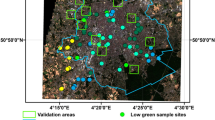Abstract
The urban mixed land use strategy can improve the efficiency and value of land use, which is of great significance to the sustainable development of cities. Previous studies related to urban land use mainly focused on neighborhood, grid, or parcel scales. These spatial scales are not fine enough to cover the spatial structure information of the internal multi-functional mixture, which is difficult to meet the needs of fine urban planning and construction. To this end, this paper proposes an urban mixed land use decomposition model at the pixel scale with higher spatial resolution, combined with a spectral unmixing strategy. Firstly, this paper constructs a multi-source feature set to describe the natural and socio-economic characteristics of urban functions. Then, the Fully Constrained Least Squares (FCLS) model was used to extract the information of urban functional abundance. The results of the mixed decomposition were compared qualitatively and quantitatively with previous studies, and the overall accuracy was verified to be 0.833 and 0.763 for Kappa. Finally, Shannon Diversity Indicator (SHDI) was constructed to characterize the multifunctional mixed-use level of construction land units.
Access this chapter
Tax calculation will be finalised at checkout
Purchases are for personal use only
Similar content being viewed by others
References
Grant, J.: Mixed use in theory and practice: Canadian experience with implementing a planning principle. J. Am. Plann. Assoc. 68, 71–84 (2002)
Niu, N., et al.: Integrating multi-source big data to infer building functions. Int. J. Geogr. Inf. Sci. 31, 1871–1890 (2017)
Yao, Y., et al.: Mapping fine-scale population distributions at the building level by integrating multisource geospatial big data. Int. J. Geogr. Inf. Sci. 31, 1220–1244 (2017)
Zhang, J., Li, X., Yao, Y., Hong, Y., He, J., Jiang, Z.: The Traj2Vec model to quantify residents’ spatial trajectories and estimate the proportions of urban land-use types. Int. J. Geogr. Inf. Sci. 35, 193–211 (2020)
Zhang, Y., Li, Q., Tu, W., Mai, K., Yao, Y., Chen, Y.: Functional urban land use recognition integrating multi-source geospatial data and cross-correlations. Comput. Environ. Urban Syst. 78, 101374 (2019)
Liu, X., et al.: Characterizing mixed-use buildings based on multi-source big data. Int. J. Geogr. Inf. Sci. 32, 738–756 (2018)
Liang, X., Guan, Q., Clarke, K.C., Chen, G., Guo, S., Yao, Y.: Mixed-cell cellular automata: a new approach for simulating the spatio-temporal dynamics of mixed land use structures. Landsc. Urban Plan. 205, 103960 (2021)
He, J., et al.: Accurate estimation of the proportion of mixed land use at the street-block level by integrating high spatial resolution images and geospatial big data. IEEE Trans. Geosci. Remote Sens. 59(8), 6357–6370 (2020)
Liu, Y., et al.: Social sensing: a new approach to understanding our socioeconomic environments. Ann. Assoc. Am. Geogr. 105, 512–530 (2015)
Xing, H., Meng, Y., Shi, Y.: A dynamic human activity-driven model for mixed land use evaluation using social media data. Trans. GIS 22, 1130–1151 (2018). https://doi.org/10.1111/tgis.12447
Bioucas-Dias, J.M., et al.: Hyperspectral unmixing overview: geometrical, statistical, and sparse regression-based approaches. IEEE J. Select. Top. Appl. Earth Observ. Remote Sens. 5, 354–379 (2012)
Gao, S., Janowicz, K., Couclelis, H.: Extracting urban functional regions from points of interest and human activities on location-based social networks. Trans. GIS 21, 446–467 (2017)
Mohanaiah, P., Sathyanarayana, P., GuruKumar, L.: Image texture feature extraction using GLCM approach. Int. J. Sci. Res. Publ. 3, 1 (2013)
Xie, Z., Yan, J.: Kernel Density Estimation of traffic accidents in a network space. Comput. Environ. Urban Syst. 32, 396–406 (2008)
Plaza, A., Martín, G., Plaza, J., Zortea, M., Sánchez, S.: Recent developments in endmember extraction and spectral unmixing. In: Prasad, S., Bruce, L.M., Chanussot, J. (eds.) Optical Remote Sensing: Advances in Signal Processing and Exploitation Techniques, pp. 235–267. Springer, Heidelberg (2011). https://doi.org/10.1007/978-3-642-14212-3_12
Acknowledgement
This work is supported by The National Natural Science Foundation of China (No. 41901332).
Author information
Authors and Affiliations
Editor information
Editors and Affiliations
Rights and permissions
Copyright information
© 2021 Springer Nature Switzerland AG
About this paper
Cite this paper
Huang, C., Liang, X., Yang, Z., Guan, Q. (2021). A Fine-Grained Mixed Land Use Decomposition Method Based on Multi-source Geospatial Data. In: Pan, G., et al. Spatial Data and Intelligence. SpatialDI 2021. Lecture Notes in Computer Science(), vol 12753. Springer, Cham. https://doi.org/10.1007/978-3-030-85462-1_18
Download citation
DOI: https://doi.org/10.1007/978-3-030-85462-1_18
Published:
Publisher Name: Springer, Cham
Print ISBN: 978-3-030-85461-4
Online ISBN: 978-3-030-85462-1
eBook Packages: Computer ScienceComputer Science (R0)



